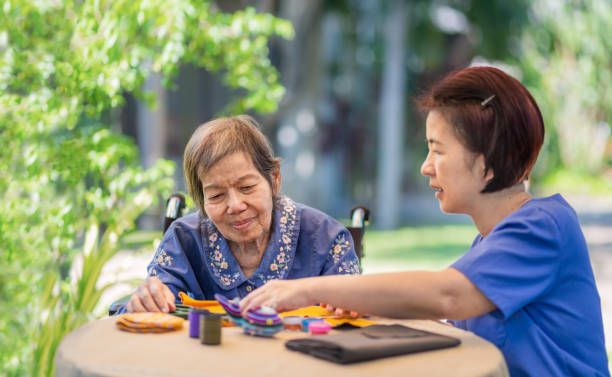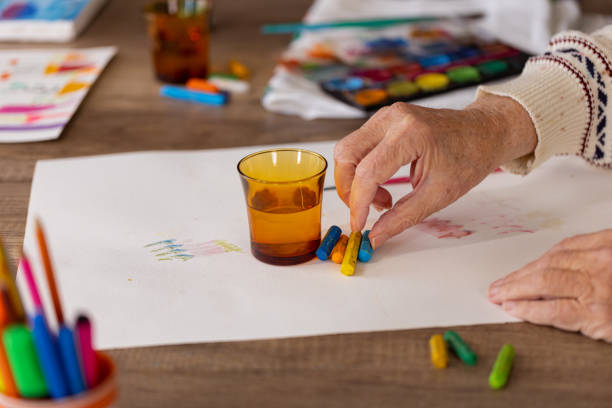Art therapy, a blend of creativity and psychology, serves as a unique approach to enhancing the mental health of individuals in memory care. This innovative technique leverages the therapeutic potential of artistic expression, providing a non-verbal medium through which individuals can communicate, explore emotions, and stimulate cognitive function. Especially beneficial for those grappling with memory-related conditions, art therapy offers a vibrant canvas upon which they can brush away the constraints of their conditions and paint a world of their own.
In this blog, we will dive into the role and significance of art therapy in memory care, elucidating its profound impact on enhancing mental health and improving the quality of life.
Contents
The Mechanism of Art Therapy
Art therapy operates on a simple, yet powerful mechanism: providing an expressive outlet that fosters emotional and cognitive resilience. Tapping into the innate creativity of the individual helps unlock subconscious thoughts and feelings, paving the way for therapeutic introspection and communication.
Emotional Expression
Art therapy allows individuals to visualize and express their emotions when words fall short. This form of therapy is particularly beneficial for those with memory-related conditions, as it provides an alternative mode of communication that transcends traditional language barriers.
Cognitive Stimulation
Engaging in artistic activities stimulates the brain, enhancing cognitive function and slowing the progression of memory-related conditions. It ignites the imagination and encourages creativity, contributing to a sense of accomplishment and positive self-esteem.
Therapeutic Benefits
Art therapy is not just about creating art, but also about the process of creation itself. The act of painting, drawing, or sculpting can be deeply soothing and therapeutic, serving as a form of meditation that promotes relaxation and reduces stress.
The Application of Art Therapy in Memory Care
In memory care settings, art therapy is employed as a vital tool to enhance mental health and improve the quality of life. The art-creation process and the final artworks themselves often serve as a mirror reflecting the individual’s emotions, memories, and self-perceptions, fostering a deeper understanding of their personal journey.
Promoting Social Interaction
Art therapy sessions often encourage social interaction, helping individuals in memory care feel less isolated. These sessions offer a platform for shared experiences, where individuals can connect with others, foster relationships, and build a sense of community through their shared love for art.
Enhancing Communication
For those struggling with verbal communication, art becomes a powerful voice. Art therapy enables individuals to express their thoughts, fears, and experiences in a non-verbal manner, fostering a deeper understanding and empathetic connection between them and their caregivers.
Personal Empowerment
Art therapy can empower individuals in memory care by providing them with a sense of control and independence, which are often lost due to their condition. The freedom to create, to choose colors, shapes, and themes, can instill a feeling of self-worth and accomplishment, thereby enhancing their overall well-being.
Memory Recall and Preservation
Art therapy can help trigger memories and preserve them in a tangible form. The process of creating art can stimulate dormant memories, while the artwork itself serves as a physical representation of these recollections, preserving personal narratives that might otherwise be lost.
The Role of Caregivers in Art Therapy

Caregivers play a pivotal role in the successful implementation of art therapy in memory care. Their support and understanding of the process can significantly enhance the therapeutic experiences and outcomes for the individuals involved.
Facilitating Artistic Expression
As facilitators, caregivers can assist individuals in the art-making process, offering guidance and encouragement. They maintain a balance between providing assistance and allowing for personal autonomy, thereby ensuring that the individual’s artistic expression remains uninhibited and genuine.
Understanding Non-Verbal Communication
Art therapy often communicates emotions and experiences that words cannot convey. Therefore, caregivers need to understand the symbolism and nuances in the artwork. This understanding can foster a deeper connection with the individuals, helping them feel seen, heard, and validated.
Creating a Supportive Environment
Caregivers are instrumental in creating a positive and supportive environment for art therapy. This involves establishing a safe space where individuals feel comfortable expressing themselves, eliminating any performance pressure, and fostering an atmosphere of acceptance and appreciation for all forms of artistic expression.
Collaborating with Art Therapists
Caregivers often work in collaboration with professional art therapists. This partnership can enhance the therapeutic process, with caregivers offering insights into the individuals’ behaviors, preferences, and responses. Likewise, art therapists can equip caregivers with techniques and approaches to support therapeutic art activities.
Conclusion
Art therapy in memory care is beyond doubt a powerful, transformative tool, offering individuals a creative outlet for expression and a potent means of communication. With its ability to stimulate cognitive function, evoke memories, and foster emotional resilience, it plays a pivotal role in enhancing mental health and overall quality of life. The role of caregivers in facilitating and supporting the art therapy process is equally crucial, contributing significantly to its efficacy.
Ultimately, while memory-related conditions may pose significant challenges, they do not have to define a person’s existence. Through art therapy, individuals can transcend these limitations, weaving a tapestry of their own experiences and emotions, and preserving their unique narratives in vibrant colors and shapes.

